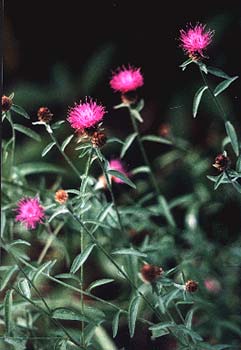
Knapweed Invaders
"A good garden may have some weeds."
-Thomas Fuller
(1608-1661)
(1608-1661)
The difference between wildflowers, uninvited cultivars arriving as volunteers, & an outright weed is occasionally a matter of perspective. In 2000, I became foolishly enamored of a random wild thistle (Onopordum sp.) growing in an unusual location out of a crack. I did not hamper its development & it grew to a sturdy compact four feet tall with gorgeous huge purple blooms. It was a most enjoyable visitor up to this point, but I sure as hell should've deadheaded it before it went to seed! It produced so damned much fluff that blew everywhere, & I have been battling its aggressive offsprings ever since. If I ever do permit another one to grow big & beautiful, I will certainly be swift to deadhead.
The weed portrait above is Centauria sp., commonly called Knapweed, related to bachelor buttons in the same family as sunflowers & asters, though having a flower that looks like a purple thistle.
I was actually a little surprised to find out they were never gardened plants that escaped & naturalized, because they do seem pretty enough to have once been planted intentionally. But no. The sundry species of knapweeds throughout North America were introduced from elsewhere in the world, & there are several species that have invaded the Pacific Northwest in particular. All either arrived in ship ballast or mixed in with imported alfalfa, a process that began in the 1880s & 1890s, with a couple newer arrivals within the present generation.
Several of these invaders look so similar (to me anyway) that I'm uncertain which one is in our yard, but it seems to be either C. nigrascens (Shortfringed Knapweed), C. nigra (Black Knapweed), or a naturally occurring hybrid, C. jacea x nigra (Meadow Knapweed). I'm leaning slightly toward it being Shortfringed Knapweed. Several other species that have naturalized in the Northwest could be ruled out for this or that reason.
This perennial knapweed has a woody root crown with a deep taproot. To be so notoriously invasive, it has not spread very far. It self-seeds in the immediate vicinity so that small knapweeds spring out of sidewalk cracks & odd places, but never more than a few feet from the primary parent plant which is a foot-wide clump I have intentionally tolerated for three years because I thought it was pretty, though smaller ones got weeded out.
For the longest while I had no idea what it was, so did not know that in Eastern Washington several knapweeds are either Class A or Class B noxious invasives. Though not officially listed as noxious for our county, even so, they do exude a growth retardant (i.e., an "allelopathic polyacetylene compound") that hinders the development of plants growing nearby; & indeed, nothing grows in the immediate vicinity of the one big knapweed clump I had been permitting to grow.
When I learned that it can hamper the development of other flowers, I became a bit more vigorous about removing them, & tore out the above specimen just as it was going to seed toward the end of August. But no garden needs to go without blossoms of the general type, because the annual Blue Bachelor Buttons (C. cyanus), & the perennial Persian Bachelor Buttons (C. dealbata), are finer substitutes anyway.